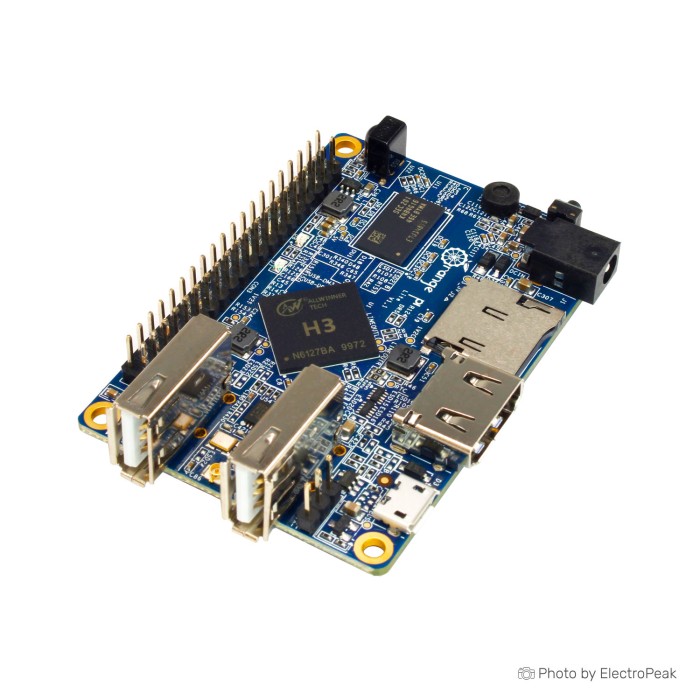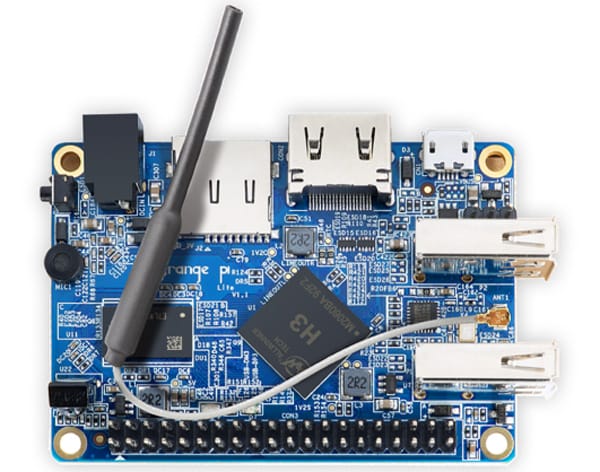Orange Pi Lite H3 Quad-core Development Board
Volume discounts:
- +10 1 % $27.5000
- +25 1 % $27.3700
- +50 2 % $27.2400
- +100 2 % $27.1200
- +300 3 % $26.9900
 Orange Pi PC H3 Quad-core Development Board
Previous
Orange Pi PC H3 Quad-core Development Board
Previous

Orange Pi Lite Quad Core Cortex A7 Board [512 MB RAM] is a complete small computer board, which consist of CPU, GPU, RAM, Wi-Fi, Microphone, Ports, and also operating systems to be placed in a robot, copters, toys, vehicles, etc., to command and control things.
The orange Pi computers are produced in different model and series of Orange Pi Zero, Orange Pi One, , Orange Pi PC, Orange Pi Plus series, Orange Pi Prime series, Orange Pi 4G-IOT, Orange Pi Win etc.
Orange Pi is an open-source computer maker which makes open-source light single-board computers with orange Pi brand. Such a single-board computer can be run under Android, Ubuntu, Debian and Armbian Image.
Specifications of Orange Pi Lite H3 Quad-core Development Board:
- Processor: Allwinner H3 system-on-chip (SoC). Quad-core ARM Cortex-A7 CPU and a Mali-400MP2 GPU @600MHz, supports OpenGL ES 2.0
- Memory: 512MB of DDR3 RAM (shared with GPU)
- Storage: TF cards (Max. 32GB) + onboard 8GB eMMC flash storage
- Networking: Ethernet (10/100Mbps) and Realtek RTL8189ETV Wi-Fi (802.11 b/g/n)
- USB Ports: Two USB 2.0 HOST, one USB 2.0 OTG
- Video Output HDMI and DSI output (Max. 1080p)
- Video Input: A CSI input camera connector (Max. 1080p 30fps)
- Supports 8-bit YUV422 CMOS sensor interface
- Supports CCIR656 protocol for NTSC and PAL
- Supports SM pixel camera sensor
- Supports video capture solution up to 1080p@30fps
- Audio Output: HDMI audio output
- Audio Input: Onboard microphone
- GPIO Pins: 40-pin GPIO header (compatible with Raspberry Pi)
- I2C, SPI, UART: Various communication protocols for connecting to sensors and other devices
- Operating System: Compatible with various Linux distributions (such as Debian & Ubuntu), Android and Armbian. You can download OS images for this SBC at Orange Pi Lite official web page.
- Buttons: Power Button(SW4)
- LED: Power led & Status led
- Other: IR input, IPX Wifi Antenna socket
- Form Factor: 69mm x 48mm
- Power Supply: 5V/2A DC input (USB OTG input don't supply power)
Orange Pi Lite H3 board components
In the picture below, you can see the typical components of the Orange Pi Lite H3 board.
- Allwinner H3 SoC: Central processing unit (CPU), containing ARM Cortex-A7 cores and Mali-400 MP2 GPU
- Memory: Totally 512MB of DDR3 SDRAM
- MicroSD Card Slot: Primary storage to host the operating system and user data
- Wi-Fi: Built-in Wi-Fi for wireless network connectivity
- USB Ports: USB 2.0 ports for connecting peripherals
- HDMI Port: For connecting to a display using HDMI
- CSI (Camera Serial Interface): A connector for connecting a camera module
- 40-pin GPIO Header: Provides access to various GPIO pins for interfacing with external devices
- DC Power Jack: Typically requires a 5V power supply
- Power Button: For powering the board on and off
- IR Receiver: IR input for control device using IR
- Microphone: Audio input by onboard microphone
Use Cases of Orange Pi Lite H3 Quad-core Development Board:
The Orange Pi Lite H3 Quad-core Development Board can be used for a variety of projects, including but not limited to:
- Home Server: Set up a home server for file storage, media streaming, or running lightweight server applications.
- DIY Media Center: Transform the Orange Pi Lite H3 Quad-core Development Board into a media center using software like Kodi or Plex for streaming and managing media content.
- Network Attached Storage (NAS): Utilize the board as a low-cost NAS solution for storing and sharing files within a local network.
- Home Automation: Build a home automation system
- Learning to Program: Ideal for learning programming languages and experimenting with hardware projects, making it suitable for educational purposes.
- Desktop Computer: Create a basic desktop computer for web browsing, document editing, and other lightweight computing tasks.
- IoT (Internet of Things) Projects: develop IoT applications and connect the board to sensors, actuators, or other IoT devices.
- Robotics: Build small-scale robots or robotic projects using the GPIO pins and other onboard interfaces.
What you need to get started with Orange Pi Lite H3 Quad-core Development Board
To get started with the Orange Pi Lite H3 Quad-core single-board computer (SBC), you'll need a few essential components. Here's a basic list to help you get started:
- MicroSD Card: A microSD card is required for storing the operating system and your data. It's recommended to use a high-quality, high-capacity microSD card (at least 8GB) like this one for better performance.
- Power Supply: The Orange Pi Lite H3 Quad-core Development Board uses a power jack. Ensure you have a compatible power supply with a rating of 5V and at least 2A to provide sufficient power.
- HDMI Cable: Orange Pi Lite H3 features a HDMI port for video output. Depending on your display, you may need a HDMI cable.
- Display: A monitor or TV with an HDMI input for connecting to the Orange Pi. Ensure it supports the resolution you plan to use.
There are HDMI displays of different sizes on the site, from which you can choose the version you want. Some displays have a touch screen and some don't. Some of touch screen are resistive and some other are Capacitive. So, be careful in choosing between them.
- Keyboard and Mouse: USB or wireless keyboard and mouse for interacting with the Orange Pi. There are some wireless keyboard at store that you can get it.
- Case (Optional): While not strictly necessary, a case can help protect your Orange Pi Lite H3 and keep it dust-free.
- Cooling (Optional): Depending on your usage, you may consider adding a heatsink or fan for cooling. The Orange Pi Lite H3 can generate more heat than previous models, especially under heavy loads.
- Operating System (OS): Download and install an operating system on your microSD card.
- Ethernet Cable (Optional): If you prefer a wired internet connection, you can use an Ethernet cable like this to connect your Orange Pi to your router or network switch.
FAQs
Here are some frequently asked questions (FAQs) about the Orange Pi Lite H3:
Orange Pi Lite H3 vs raspberry pi 4. Which one is better?
Does Orange Pi Lite H3 runs 64 bit OS?
Orange Pi Lite H3 typically runs a 32-bit operating system. The Allwinner H3 processor, which is used in the Orange Pi Lite H3, has a 32-bit ARM Cortex-A7 architecture. As a result, the majority of operating systems and software distributions available for the Orange Pi Lite H3 are designed for 32-bit systems.
How do I start up the Orange Pi Lite H3?
Please read this article to understand how to get started with Orange Pi Lite H3.
Can I use the Orange Pi Lite H3 as a desktop computer?
No, the Orange Pi Lite H3 cannot be used as a basic desktop computer. Because the performance of the Orange Pi Lite H3 is too far weaker compared to a high-end desktop computers.
Keep in mind that the Orange Pi Lite H3 is more suitable for lightweight computing tasks and educational purposes rather than demanding desktop applications or heavy multitasking.
What is the purpose of the GPIO pins on the Orange Pi Lite H3?
The GPIO (General Purpose Input/Output) pins on the Orange Pi Lite H3 allow it to interact with and control external hardware, such as sensors, LEDs, and other devices. You can learn how it works at this article.
Which SBCs are main competitors of Orange Pi Lite H3?
Orange Pi Lite H3 competes in the single-board computer (SBC) market with various other boards that offer similar capabilities, price points, and features. Here are some of the main competitors of the Orange Pi Lite H3:
- Raspberry Pi 3 Model B+ and Raspberry Pi 4: The Raspberry Pi series is one of the most popular and widely used SBCs. Both the Raspberry Pi 3 Model B+ and Raspberry Pi 4 offer competitive features, performance, and a large community of users.






Please complete your information below to login.
Sign In
Create New Account